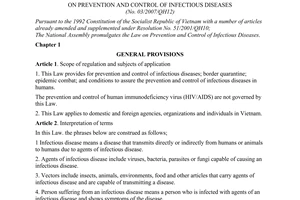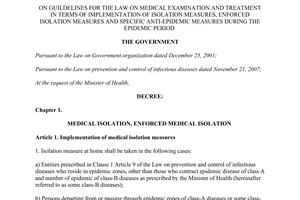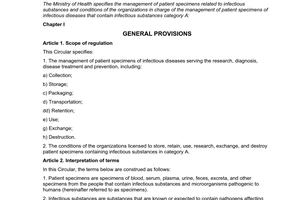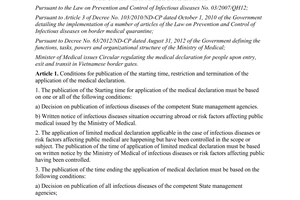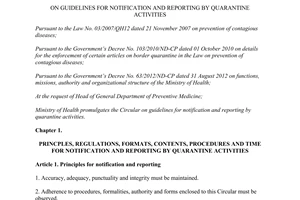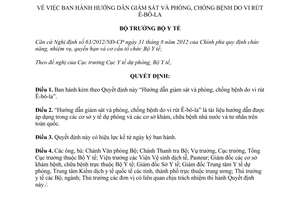Nội dung toàn văn Decision No. 2914/QD-BYT 2014 on issuing guidance on surveillance, prevention of Ebola virus disease
|
MINISTRY OF HEALTH |
SOCIALIST
REPUBLIC OF VIETNAM |
|
No.: 2914/QD-BYT |
Hanoi, August 06, 2014 |
DECISION
ON ISSUING GUIDANCE ON SURVEILLANCE, PREVENTION OF EBOLA VIRUS DISEASE
MINISTER OF HEALTH
Pursuant to Decree No. 63/2012/ND-CP dated August 31, 2012 of the Government defining functions, duties, power and organizational structure of the Ministry of Health;
At the request of Director of Department of Preventive Medicine under the Ministry of Health.
Article 1. Issued together with this Decision the “Guidance on surveillance, prevention of Ebola virus disease”.
Article 2. The “Guidance on surveillance, prevention of Ebola virus disease” is the guiding material which is used at preventive healthcare facilities and private and state medical facilities nation-wide.
Article 3. This decision takes effect from the date of its signature.
Article 4. Chief of Ministerial Office, Ministerial Chief Inspector, Head, Director of Department, General Director under the Ministry of Health, Head of Institute of Hygiene and Epidemiology, Pasteur Institute, Directors of medical facilities directly under the Ministry of Health, Director of Department of Health, Director of Preventive Medicine Center, Director of Center for International Health Quarantine of provinces and centrally-affiliated cities, Head of medical agencies of Ministries and sectors and Head of organizations concerned are liable to execute this Decision./.
|
|
FOR THE MINISTER |
GUIDANCE
ON SURVEILLANCE, PREVENTION OF EBOLA VIRUS DISEASE
(Issued together with this Decision No. 2914/QĐ-BYT dated August 06, 2014 of the Minister of Health)
I. GENERAL CHARACTERISTICS
The Ebola virus disease (Ebola haemorrhagic fever) is a dangerous acute infectious disease (infectious disease of group A) and is capable of rapid spread with high mortality rate (up to 90%). This disease is spread from person to person through direct contact with blood, secretions, organs of infected people, animals or exposure to environments contaminated by fluid of infected humans or animals. The chimpanzees, apes, monkeys, antelopes and African porcupines can be a viral reservoir which is capable of spread to humans or infected people and potential viral carriers can also serve as a infection source in the cycle of person-to-person infection.
The first outbreak of Ebola disease was identified in 1976 in Sudan with over 600 infected cases. Since then, this disease has occurred in 11 African countries, especially from March 2014 to August 01, 2014, there were 1,603 infected cases including 887 deaths reported in the world in 04 countries: Guinea (485 cases / 358 deaths) Liberia (468 cases / 255 deaths), Nigeria (4 cases / 1 death), and Sierra Leone (646 cases / 273 deaths), especially over 100 infected healthcare workers have been infected by Ebola virus disease.
People infected with Ebola virus disease have symptoms of acute viral infection and sudden onset with high fever, headache, pain at abdominal and chest muscles, sore throat, vomiting or nausea, acute diarrhea ( ligature sign, purpura or maculopapular, epistaxis ) and visceral haemorrhage (vomiting, bloody diarrhea ...). The typical severe state is liver damage, kidney failure, inflammation of cerebral organization, possible multiple organ failure, pleural effusion and shock. A number of infected people with atypical clinical expression should be diagnosed and distinguished from a number of viral infections causing haemorrhage, yellow fever, West Nile fever and Dengue fever. No antiviral vaccine or medicine has proved effective in treating this viral disease.
The Ebola virus disease has not been identified in Vietnam. However, it is a very dangerous disease causing great concern to the international community.
II. GUIDANCE ON SURVEILLANCE
1. Definition of cases
1.1. Suspected cases
Cases of suspected infection with the following signs:
- Sudden high fever
- Weakness, headache, muscle pain
- Sore throat, vomiting, nausea, acute diarrhea,
- Rash, in some cases with expression of epistaxis, vomiting or bloody diarrhea.
- Epidemiological factors: History of living, going to or coming from the affected regions/nations or having exposure to infected people or animals within 21 days.
- No direction to other causes.
Exposure includes:
- Person directly takes care of, lives or works with the infected person in the same family or office.
- Direct exposure to cases of infection in any circumstances.
1.2. Confirmed cases
It is a suspected case with positive result by Elisa test to detect the anti-ebolavirus IgM antibody or RT-PCR reaction to detect the viral genetic marker
2. Definition of disease reservoir
2.1. Disease reservoir: a place (hamlet, village, group, unit, border gate…) records an identified case or more.
2.2. End of disease reservoir: upon no record of new infection within 21 days from the onset day of the last case.
3. Laboratory testing.
- Type of specimen: The specimen is whole blood or serum, urine, secretion, viscera sample to identify virus / virus antibodies.
- Test method: ELISA, RT-PCR, virus isolation.
- This is a very dangerous disease which requires strict biosafety. The testing of Ebola suspected specimen must be conducted at the laboratory with appropriate biosafety.
- Staff of laboratory must be trained about biosafety for virus of this type of disease group.
- Collection, preservation, packaging and transportation of Ebola suspected specimen (details specified in the attached Annex 1).
4. Contents of surveillance
4.1. Scenario 1: No case recorded in Vietnam
Surveillance and detection at border gate: to conduct screening for early detection of suspected cases in the border gate area to promptly isolate and limit spread and consider applying medical declaration at international border gate in accordance with the situation of Vietnam and international practices.
Close surveillance in the community and health facilities for suspected Ebola cases and a history of travel from affected areas within 21 days for early detection of first suspected cases, rapid diagnosis, localization and timely and thorough treatment of disease reservoir to prevent spread.
Method of surveillance in this scenario:
- At border gate: using body temperature sensor, physical observation, isolation and specimen taking for laboratory test for suspected cases.
- In the community: epidemiological survey and specimen taking for laboratory test of all cases subject to monitoring including suspected Ebola cases and a history of living, going to or coming from the affected regions/nations or having exposure to Ebola confirmed people or animals or Ebola patients related to the affected regions/nations within 21 days prior to the onset.
4.2. Scenario 2: Occurrence of confirmed cases entering Vietnam
The requirement of this scenario is early detection of cases related to entering cases to thoroughly treat the reservoir to prevent spread to communitiy.
Method of surveillance in this scenario is as follows:
- Surveillance, epidemiological survey, specimen taking for laboratory testing of all cases subject to the surveillance.
- Surveillance and monitoring of health condition of all people having exposure to infected cases within 21 days from the last exposure.
4.3. Scenario 3: Spread of disease in community
The requirement of this scenario is the early detection of newly-infected cases in community, thorough treatment of reservoir and minimization of further spread in community.
Method of surveillance in this scenario is as follows:
- In localities without record of infected case: Surveillance, epidemiological survey and specimen taking of all suspected cases based on the definition of case.
- In confirmed reservoirs: Surveillance, epidemiological survey and specimen taking of first detected cases.
In three scenarios, all cases of death suspected with Ebola virus must be investigated, reported and their specimen must be taken for laboratory testing.
4.4. Collection, preservation and transport of specimen: to be done in compliance with the provisions in the Circular No. 43/2011/TT-BYT dated December 05, 2011 of the Ministry of Health regulating the management of specimen of infectious diseases.
4.5. Information and report
To carry out the information and report with respect to infectious diseases of group A in accordance with the provisions of the Law on prevention and control of infectious diseases; Circular No. 48/2010/TT-BYT dated December 31, 2010 of the Ministry of Health guiding the regulations on declaration, information and report on infectious diseases and other legal documents concerning the information and report on diseases and Circular No. 15/2014/TT-BYT dated May 15, 2014 of the Ministry of Health guiding the information and report on medical quarantine
III. PREVENTIVE MEASURES
1. Preventive measures
- Propagating the Ebola disease and preventive measures to people, especially those coming to Vietnam from the affected regions or Vietnamese people coming to the affected regions to have knowledge of prevention upon warning of entering of Ebola virus.
- Avoiding exposures to Ebola infected people as well as their blood, secretion, infected animals and objects capable of viral infection. In case of necessary exposure, the use of personal protective equipment is required.
- Implementing measures of personal hygiene such as frequent hand wash with soap.
- Regularly cleaning floor, objects, stairs…with Chloramines B or conventional chemical disinfectants.
- Immediately notifying the nearest medical facilities upon expression of Ebola disease for timely advice, isolation and treatment.
2. Border medical quarantine
- The measures of border medical quarantine is very important to promptly detect the suspected cases possibly entering from affected regions in the world.
- Providing guidance on regulations on surveillance, control, handling, prevention and control of Ebola virus disease to medical workers, especially those working at border gate areas.
- Implementing the surveillance of people entering the country with remote body temperature sensor and other measures under the guidance of the Ministry of Health. Applying the medical declaration in accordance with the provisions in Circular No. 32/2012/TT-BYT dated December 24, 2012 of the Ministry of Health.
- The isolation and medical handling at border gate apply to infectious diseases of group A under the provisions in Decree No.101/2010/ND-CP dated September 30, 2010 of the Government detailing the implementation of a number of articles of the Law on prevention and control of infectious diseases on application of medical isolation, coercive medical isolation and specific disease control during the occurrence of disease.
- Implementing the communication measures to prevent and control of Ebola virus disease for passengers at border gate areas as recommended by the Ministry of Health.
3. Full preparation of materials, chemicals and equipment upon occurrence of disease
- Personal protective equipment for disease prevention, emergency and treatment medicine.
- Chemical disinfectant
- Chemical sprayers
- Isolation area.
IV. MEASURES OF DISEASE CONTROL
1. Implementing the preventive measures as mentioned in part III
2. Additional measures
2.1. For infected people
- Isolation and treatment at medical facilities as guided by the Ministry of Health.
- Proper use of personal protective equipment to limit disease infection and transmission.
- Limitation of exposure and transportation of patient. In case of necessary transportation, the use of personal protective equipment and special use vehicle is required. The contaminated objects, waste items and waste of infected people must be disinfected and treated under regulations.
- Corpse handling is in accordance with the provisions of Circular No. 02/2009/TT-BYT dated May 26, 2009 of the Minister of Health guiding the sanitary burial and cremation.
2.2. For exposed people
- The patient caregivers must comply with measures of personal protection (mask N95, eye protection glasses, hats, gloves, shoe coverss, clothing) and wash hands immediately with soap or other antiseptic solution after each exposure to patient.
- Maximum limitation of exposure to patients
- Implementation of good personal hygiene, frequent hand wash with soap and disinfectant chemicals; use of antiseptic medicine for nose and throat.
- Listing of exposed people and follow-up of health condition within 21 days from the last exposure. Advice is given to the exposed people about signs of disease and measures of prevention and control, self monitoring and early detection of symptoms of Ebola disease. If there are symptoms of disease, the exposed people must notify the nearest medical facility immediately to be diagnosed and treated in a timely manner.
2.3. nfection prevention at treatment facilities
Strictly implementation of patient classification for examination, isolation and treatment, measures to control infection, personal protective equipment for medical officers, patient caregivers and other patients at treatment facilities as guided by the Ministry of Health.
2.4. Environmental disinfection and remediation
- Waste of patients must be thoroughly treated with a chemical disinfectant solution with active chlorine concentrations of 1.25% - 2.5% at the ratio of 1: 1 in at least 30 minutes then poured into sanitary latrines or pits for stool collection and treatment.
- Patients’ used clothing, blankets, utensils during their illness must be dipped or flushed with boiling water or soaked in a chemical disinfectant solution with active chlorine concentration of 0.5% in 1 - 2 hours prior to washing.
- Vehicles used to transport patients must be disinfected or decontaminated with a chemical disinfectant solution with active chlorine concentration of 0.5%.
- Isolation area and patients’ home must be disinfected by cleaning with a chemical disinfectant solution with active chlorine concentration of 0.5%.
- Objects and items in patients’ home must be cleaned with a chemical disinfectant solution with active chlorine concentration of 0.5%.
There is no effective vaccine or medicine for this disease. Therefore, the prevention mainly focuses on early detection, strict isolation and implementation of personal protective measures and infection control in accordance with regulations.
Depending on the development of Ebola disease and recommendations of the World Health Organization, the Ministry of Health will update and adjust its guidance accordingly.
ANNEX 1
GUIDANCE ON COLLECTION, PRESERVATION, PACKAGING AND TRANSPORT OF EBOLA VIRUS SUSPECTED SPECIMEN
I. COLLECTION OF SPECIMEN
The Ebola virus disease (Ebola haemorrhagic fever) is a dangerous acute infectious disease (infectious disease of group A) and is capable of rapid spread with high mortality rate (up to 90%). Therefore, the Ebola virus suspected specimen must be collected by the medical workers who have been trained for biosafaty
1.1. Type of specimen:
- Full blood
- Urine, secretion
- Vicera specimen
1.2. Time of collection
|
Type of specimen |
Appropriate time for collection |
Testing techniques |
|
Specimen of blood / serum at acute phase
|
On day 0 – 7th after the onset of disease |
- ELISA IgM - RT-PCR - Virus isolation |
|
Specimen of blood / serum of at recovery phase |
On day 14, 28th or 3 months after the onset of disease |
|
|
Urine and secretion |
On day 0 to 14th after the onset of disease |
|
|
Visceral specimen |
In case of order |
1.3. Method specimen collection
1.3.1. Tool preparation
1.3.1.1. Blood collection tool:
+ Retracting tube (no anticoagulant);
+ Blood collection needle (the type used for blood collection with retracting tube);
+ Plastic tube holder to fix needle and retracting tube.
+ Alcohol pads, tourniquet, box for sharp or pointed things, waste nylon bag, nitrogen liquid vessel for specimen preservation.
1.3.1.2. Tool used to collect urine or secretion:
The specimen collected is contained in tube with transparent label. No use of tube to contain glass material.
1.3.1.3. Personal protective costume:
Mask N95, eye protection glasses, face shields, hats, gloves, shoe coverss, clothing.
1.3.2. Specimen collection
1.3.2.1. Use of protective costume
Ebola virus disease is an infectious disease of group A. Therefore, in addition to personal protective equipment as for hazardous agents such as SARS-CoV, MERS-CoV, A/H5N1 influenze, the collection of Ebola suspected specimen must be done with glasses and face shield.
|
Prior to specimen collection (wearing) |
After specimen collection (taking off) |
|
Mask N95 |
Gloves – second layer |
|
Hat |
Clothing |
|
Protection glasses |
Shoe covers |
|
Face shield |
Face shield |
|
Clothing (not absorbing water or secretion) |
Protection glasses |
|
Gloves – first layer |
Hat |
|
Gloves – second layer |
Mask N95 |
|
Shoe covers |
Gloves – first layer |
* 2-layer gloves:
- First layer: must be kept clean and avoid exposure to contaminated tools
- Second layer: used to collect specimen and replaced if torn. Before removing this glove layer, it is required to spray alcohol on the entire glove surface.
1.3.2.2. Collection technique
a. For blood specimen
- Write the patient’s name and code on vaccuum tube;
- Choose appropriate vein: blood is usually collected at elbow crease;
- Insert needle into fixed plastic tube holder;
- Tie tourniquet 5 cm above puncture site
- Thoroughly cleanse the skin and leave it dry;
- Insert the needle into the vein
- Press the plunger into the fixed plastic tube holder and draw adequate volume of blood needed and avoid air bubbles;
- Untie tourniquet, draw out needle and gently press the alcohol pad on the puncture site;
- Remove the retracting tube
- Remove needle out of the fixed plastic holder
* Note: Take utmost caution upon use needle and sharp objects
b) For specimen of urine or secretion:
- Urine: collect 2-3 ml of urine into plastic tube
- Secretion: collect secretion into plastic tube containing 3ml virus transport medium.
c) For visceral specimen:
Work with clinical doctoe (in case of order).
1.3.2.3. Sterilization of tools and disinfection of sampled area
- All protection clothing and contaminated tools prior to destruction must be disinfected with active chlorine 0.5% and put into a special use nylon bag for medical waster capable of withstanding high temperature. Tie and dry it wet at 120oC/30 minutes prior to destruction with other medical waster or burned in furnaces of district-level hospitals
- Use active chlorine 0.5% to disinfect all tools and sampled area and nitrogen liquid vessel for specimen transport to the laboratory.
- Hand wash with soap.
II. PRESERVATION, PACKAGING AND TRANSPORT OF SPECIMEN
2.1. Preservation
After being collected, the specimen is transported to the laboratory within a shortest time.
- The specimen is preserved at 2-8oC and transported to the laboratory within 24-48 hours after collection.
2.2. Packaging
When transporting the specimen, it must be packaged in 03 protection layers under the provisions of the International Air Transport Association (IATA) for pathogen of group A
▪ Layer 1: Tube containing direct specimen with close cap.
▪ Layer 2: Box/bag to contain the specimen tube: absolutely firm and tight and capable of absorption of solution in case of spillage/break of specimen tube (blotting paper..)
▪ Layer 3: Container to hold box/bag with specimen tube: firm and capable of insulation and without leakage
- When transporting the specimen, ensure the specimen container must be firmly placed and avoid collision
- There may be a survey/testing slip outside the container (not put the slip together with the specimen)
2.3. Specimen transport to laboratory
- Specimen receiving unit:
+ The laboratory of National Institute of Hygiene and Epidemiology receives specimen sent from from Quang Ngai province to the North.
+ Pasteur Institute of HCM City receives specimen from Binh Dinh province to the South.
- The laboratory will be notified of the sending date and expected arrival time.
- Speciment will be transported to the laboratory by road or by air as soon as possible.
- Absolute avoidance of spillage or break during transportation.
------------------------------------------------------------------------------------------------------
This translation is made by LawSoft and
for reference purposes only. Its copyright is owned by LawSoft
and protected under Clause 2, Article 14 of the Law on Intellectual Property.Your comments are always welcomed
